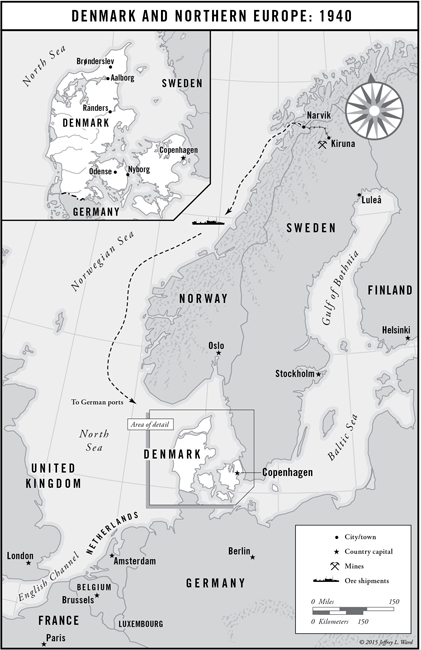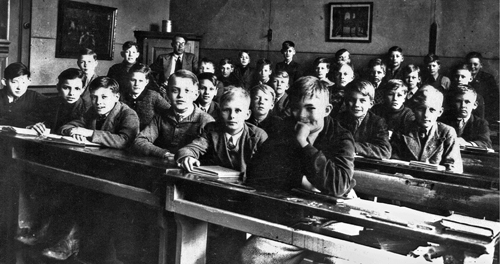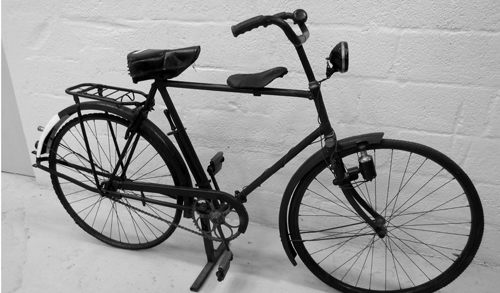

With the occupation of Denmark and Norway, Hitler had now overwhelmed a second and third nation, the first being Poland in 1939. Denmark may have been tiny, but it was strategically prized by the Nazi regime: the country provided railroad lines to transport iron ore from Sweden and Norway to Germany for use in fashioning weapons. Denmark’s fertile farmlands could now feed millions of Germans butter, pork, and beef. Geographically, Denmark stood between Britain and Germany— a valuable buffer. Beyond that, Adolf Hitler regarded Danes as model Aryans. Many were blond and blue-eyed, exemplars of the “master race” Hitler believed in—the perfect people. If Germany could win, Denmark would be a charter member of the world’s ruling elite.
KNUD PEDERSEN: A group of us boys in Odense, my older brother, Jens, and my cousins included, started reading the newspapers every day. They were filled with stories of Norwegian civilians being murdered by German troops. The Germans had already started censoring the news, and these reports were supposed to impress readers with the mighty German war machine. But the stories were sickening: twenty-five young Norwegian soldiers rounded up and executed in one town, thirty in another. Wailing families held back by guards. Two young women gunned down in Ringerike. Four unarmed civilians shot at Ringsaker—one of whom was shot in the back, but the bullet went through the neck and came out his jaw. Through all the horror, Norwegians kept fighting.
Jens and I, and our closest friends, were totally ashamed of our government. At least the Norwegian victims had gone down in a country they could be proud of. Our small army had surrendered to German forces within a few hours on April 9. Now there was no armed, uniformed force to stand up for us. We were furious at our leaders. One thing had become very clear: now any resistance in Denmark would have to come from ordinary citizens, not from trained soldiers.
Everything changed in those first weeks, even our family. We had been this settled pastor’s family, our lives organized around father’s church services. We tried to keep the house quiet as Father puffed on his long pipe in his office and prepared his sermons during the week. Women crowded into our living room to take tea with Mother. Sometimes she could be persuaded to play Mozart on the piano.

Knud Pedersen, a few months before the German occupation. He is front and center, hand to mouth
But after April 9, my father became agitated and defiant. “May God forgive the Nazis,” he thundered from his pulpit during his Sunday sermons. “I cannot!” He screened every new friend we brought into the house. “Who is his father?” he would demand. “Is he a Nazi?” My father forbade me and Jens from even asking for a Boy Scout uniform. Hitler Youth wore uniforms. Now Father hated all uniforms.
Edvard Pedersen’s Views on Scouting
Boy Scouts and Girl Scouts were very popular in Denmark in the war years. There were at least ten Danish scouting organizations. Sprinkled throughout Denmark’s countryside were hundreds of Scout Huts where the groups could gather for camping or rallies. Edvard Pedersen forbade his sons Jens and Knud from becoming Scouts because he distrusted the military aspects of scouting—uniforms, oaths, a command structure. He feared that during the German occupation the Danish Scout movement could be taken over by the Hitler Youth, which delivered a steady stream of German boys—indoctrinated by the hate-filled Nazi ideology of racial and national superiority—to the German armed forces. As Hitler put it, “He alone who gains the youth, owns the future.”
At night we would gather in his study to listen to radio broadcasts from England. The show from the BBC would begin with the first four notes from Beethoven’s Fifth Symphony and then the firm, confident voice that said, “This is London calling.” Then war news of aerial battles and troop skirmishes. That was for me.
When school let out for the summer we took our usual family holiday to the western coast of Denmark on the North Sea. It was a total waste for me. I kept asking myself: How on earth could I lie on the beach sunning when my country had been violated? Why were we not as brave as Norway? Had Denmark no pride?
By the time we got back to Odense, in the summer of 1940, Jens and I had reached the same conclusion: if the adults would not act, we would.
* * *
A few days after they returned to Odense, Knud and Jens met in the quiet calm of the churchyard with their cousin Hans Jøergen Andersen and their friends Harald Holm and Knud Hedelund. The two Knuds were best friends at school, known universally as “Big Knud” and “Little Knud,” since Pedersen was nearly two feet taller than Hedelund.
KNUD PEDERSEN: The topic was whether or not to form a resistance unit. My brother Jens thought we should wait a little longer, until we could recruit more members. I felt just the opposite. My idea was to get going—members would come when they saw results. Hans Jøergen was likewise a man of action: he was ready. Harald usually had his head in the clouds about some intellectual problem or another, but this time he was as disgusted with our politicians and the king as we were. “Britain and France will never want us as allies when we make the Germans so comfortable,” he kept saying. Little Knud was ready to go—as usual. So our club was voted into existence that day. It was Harald who suggested we call ourselves the RAF Club after the heroic British Royal Air Force.
“So, we exist. Now what do we do?” That’s what we all were thinking. We were few; the Germans were many. They were fully trained, bulging like goons with their weapons. We had no weapons at all and wouldn’t have known how to use them even if we were armed to the teeth. We rode our bikes downtown to the central square to scope things out. Right away we spotted all these freshly planted directional signs. They were yellow and black, not the usual bright red Danish signs. They had black arrows pointing this way and that. Clearly they had just been put up by the Germans to direct the newly arrived soldiers to their barracks and military headquarters. One sign hung suspended from a wooden arm. It was a choice target. Two of us backed up our bikes, counted off, and pedaled full speed at the sign, one on either side, and smashed the thing to the ground. Then we twisted other signs around so they pointed in the opposite directions from what was intended. We were doing these things in broad daylight, right after school. Plenty of people saw us, and we could see them pointing, but we struck lightning-fast and got out of there. In and out quickly—that became RAF Club style.
RAF
Throughout the summer and fall of 1940, the boys from Odense listened to radio broadcasts recounting the furious aerial struggle of the Battle of Britain. Their heroes were the pilots of the British Royal Air Force (RAF). Badly outnumbered by the German Luftwaffe, but assisted by air squadrons from Poland, Czechoslovakia, and other nations, the RAF pilots valiantly defended the skies over Britain and kept their country free. The grueling battle claimed many lives. The RAF’s success thwarted Hitler’s plan to invade the United Kingdom. The pilots’ courage prompted British prime minister Winston Churchill to say in the House of Commons on August 20, 1940, “Never in the field of human conflict was so much owed by so many to so few.” Deeply inspired, the Odense boys paid them tribute, naming their group the RAF Club.
Our bicycles were our weapons. We carved concentric circles on our bicycle seats to mimic the RAF insignia. We would look with pride at those circles and vow to use our bikes like the British pilots used their planes. Mine was black and rusty, and I called it the Iron Horse. We hung out in front of the Phoenix Cinema in Odense, where they showed westerns. John Wayne had his horse. We had our bikes. Like John Wayne, we were all fast and daring riders.

“Our bicycles were our weapons”
Hitler and Bicycles
The RAF Club may have been the first saboteurs in Denmark to strike from bicycles, but they were far from the last. The practice increased throughout the war. In October 1944, General Hermann von Haneken, chief of the German high military command in Denmark, ordered all Danish bicycles confiscated. Von Haneken’s Nazi political rival Werner Best protested in writing to high Nazi officials, pointing out that since nearly all workers in the food export business rode their bicycles to work, taking bikes away would mean less Danish food for Germans. The delicate issue was finally decided by Adolf Hitler himself. On October 26, Hitler ordered that only unsold bikes from Danish bicycle shops should be confiscated. Hitler sought to keep the action mum, but angry Danes watched German soldiers snatch unlocked bikes from parking lots and fling them into the backs of trucks. Underground papers declared bicycle theft to be “Hitler’s secret weapon.”
After school the second day we rode back downtown, looking for more ways to disrupt our occupiers. This time we discovered telephone lines linking German military headquarters to the barracks where soldiers slept. They were not electric lines, so there was no danger that we’d fry ourselves if we messed with them. We went out on our bikes, Hans Jøergen, Little Knud, and me, tracing the lines to German-controlled buildings. We found a place next to a tree where the line was only a couple of meters off the ground. It was an easy reach for me. I climbed out on a limb and snipped the wire with garden shears. In the next several weeks we cut those lines again and again.
We struck repeatedly throughout the autumn of 1940, and we began to get a reputation in Odense. We had a particular style. Word got around about the cut wires, and everyone could see the mangled signs. I remember standing in the lobby of the Phoenix Cinema and hearing other kids talking about the saboteurs. Who were they? everyone wondered.
The Germans ordered the Danish police to crack down or else the Germans would take over the police force. That was last thing the Odense police wanted. They assigned eight officers to capture us. Suddenly there were police on the street corners where food was sold at kiosks, asking questions: Did anyone know who cut the lines? Did anyone have any information? The Odense police commissioner ran an announcement in the Odense newspaper offering three hundred Danish kroner to the provider of information leading to our arrest.
Clearly we had their attention: three hundred kroner was three months’ wages in a factory back then.